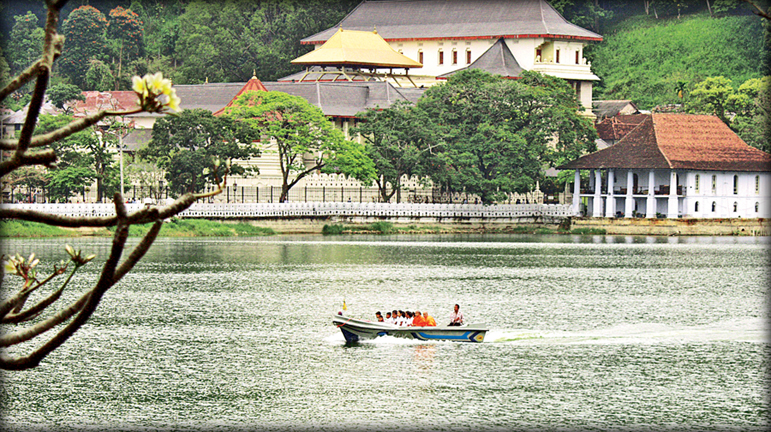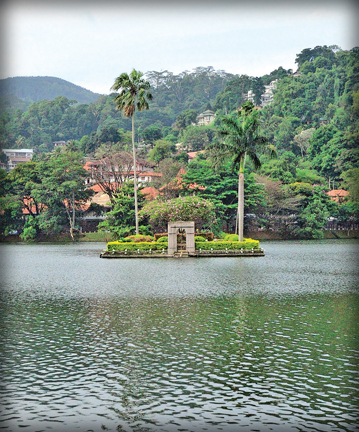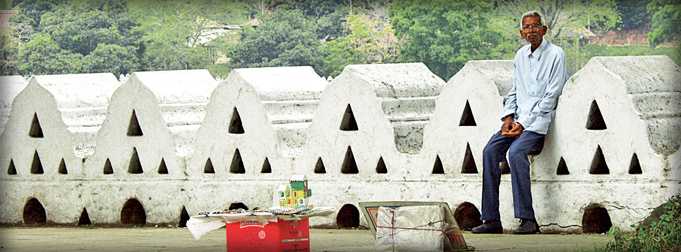|
A walk around the Kandy Lake:
Savouring the everyday and the exotic
Story and pictures by Mahil Wijesinghe
|

A view of the lake from Queen’s Hotel |
Nature photographers love water and light. Perhaps they see poetry in
the blending of two of nature's bounties. I see a shimmering, pulsating
painting on the verge of coming alive.
I was in Kandy last week to document one of the city's landmark
features, the Kandy Lake, and spent half the day just walking and gazing
at this enchanting man-made body of water, absorbing the hustle and
bustle of daily life around it.
Lovingly nestled in a valley, protected by the hills, dominated by
the tree covered lake with the mighty Mahaweli gushing in the
background, the city of Kandy is still a focal point of Sri Lankan
culture. It was the capital of the Kandyan Kingdom and the centre of
governance for the last generation of the country's kings.
Today, Kandy is known by several names, popular among them
Senkadagala, Maha Nuwara and Kandy. To many, it is the Maha Nuwara, the
'great city.' But the name Kandy was derived from the word kanda, which
means mountain. Located 500 metres above sea level, Kandy city is indeed
surrounded by the Knuckles, Madulkele, Dolosbage and Kotmale mountain
ranges, and accessible only by a series of steep road and rail passes.
The beautiful Kandy Lake is one of the main draws of the city.
Constructed by the last King of Kandy, Sri Wickrama Rajasingha, during
his reign from 1798 to 1815, it was originally named (by the King) as
Kiri Muhuda or 'Milky Sea'. It is said commoners in the city were
against the lake project, as the King enforced, free labour to construct
and complete it. They also did not see much use in a Lake that did not
irrigate the paddy fields. But the King delighted in feeding boiled rice
to the multitude of fish that resided there. On the island in the middle
of the Lake, the King built a pleasure house, where some say he kept his
harem, but today, it a small well-maintained flower garden and plays
host to egrets, herons and water monitors.
Calm your soul
Most of the visitors to Kandy, after venerating the Sacred Tooth
Relic at the Sri Dalada Maligawa, walk through the promenade of the
Kandy Lake. It is a perfect place to empty your mind and just relax
allowing the soothing water to calm your soul. I too follow tradition,
when I arrive in the early hours. Sri Dalada Maligawa is always a busy
place with foreign tourists, school children and hundreds of devotees
clad in white who throng to venerate the sacred Tooth Relic of The
Buddha. Deemed a UNESCO World Heritage site, the Maligawa lies in the
cultural triangle of Sri Lanka and is renowned all over the world.
|

The ‘pleasure house’ |
A crowd of noisy devotees clad in white and monks in saffron-robes
attracted my attention. Unable to resist the temptation, I pulled out my
camera and began to stroll the promenade around the Kandy Lake, eager to
capture in my frame the life and signs of devotion around me. I soon
found myself walking around the fenced promenade of the Lake toward
Sangaraja Mawatha, blissfully comforted by the lush foliage around it.
Halfway down the south shore of the lake, I glimpsed the magnificent
Malwatta monastery, lying in all its ancient grandeur. The old Vihare
may date back to the 16th Century, but amidst its ancient splendour, the
movement of the ubiquitous saffron-clad monks is indeed a sight to
behold.
Soon I reached the middle of the promenade and sat for a while on one
of the benches placed along the promenade. This is where most of the
visitors to this historic city pause and relax to take in the beauty of
the lake and the bustling city in the periphery and the quietude of the
Maligawa.
Business for the vendors is always brisk here, with everything from
lotteries to toys and chick peas and raw mangoes, snapped up with greedy
delight. But what attracts the attention is the people, the bhikkhus,
foreign tourists, office workers, children, young couples, women clad in
traditional Kandyan saris who stroll serenely beside the Walakulu Bemma,
or the 'cloud wall' the parapet wall modelled to resemble clouds. The
Walakulu Bemma, is one of the main landmarks of Kandy and its design is
so well crafted that it greatly enhances the scenic appeal of the Lake.
Harmony and disarray
The Walakulu Bemma is Britain's contribution to Kandy. History has it
that after Kandy surrendered to the British in 1815 officials of Her
Majesty were known to stroll along the promenade around the Lake. This
wall contains triangular holes, which has been used to light oil lamps
during the Esala Perahera festival.
Heading south along the embankment of the Lake, you will pass the
boat jetty protruding from a small house at the edge of the Lake. For a
few rupees, a small motor-powered fibre boat will take visitors on a
breezy joy ride around the Lake.
The entire spectrum of the majestic Dalada Maligawa and the lush and
relatively untouched vegetation of the Udawattekele, which has some 160
acres of tropical rainforest, provide a haven to rare flowers, birds and
monkeys. They in turn give a serene setting to the Lake, so much so, it
is hard to tear the eyes away.
A busy roadway circles the lake allowing the visitors to stumble up
several historical monuments, the most interesting being the Magul
Maduwa, an audience hall characteristic of Kandyan architecture with
wooden columns. Some of the old colonial architectural buildings such as
Hotel Suisse and Queen's Hotel stand majestically near the lake.
Today, Kandy city, built to harmonize with the environment, stands
out like a sore thumb amidst the unplanned modern development, oozing in
all directions. The huge trees that once adorned the hills are
disappearing day by day, allowing the concrete jungle to encroach into
the hilltop.
The Kandy Lake is a magnificent legacy that speaks of a bygone era
and transforms the hill capital into a place of beauty. But some of the
springs which once fed the lake are drying up and many of them are
blocked due to rapid development. If the situation is allowed to
continue, the beauty of Kandy Lake will be something we will bemoan the
loss of.
|

Walakulu Bemma |
|

